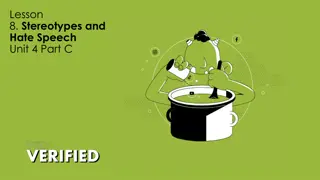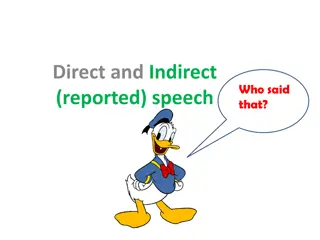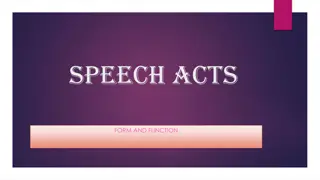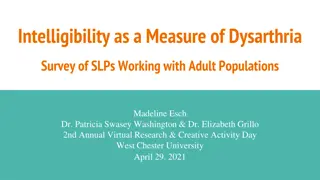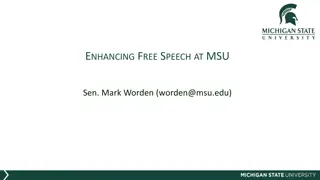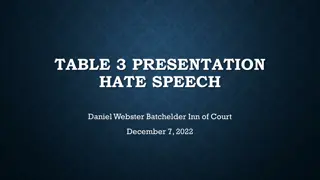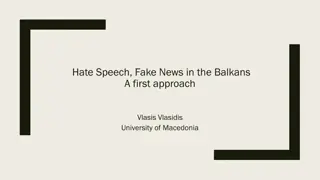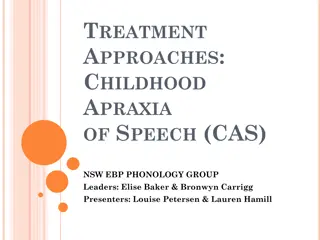Exploring Fictional Speech and Phonostylistics in Literature
Delve into the realm of fictional speech and phonostylistics within literature, examining the representation of speech versus real speech, the encoding of spatial, social, and attitudinal markers, and the significance of fictional speech in creating immersive narratives. Discover how authors navigate the balance between realism and artistic expression, shaping readers' engagement through the manipulation of language and dialogue in fiction.
Download Presentation

Please find below an Image/Link to download the presentation.
The content on the website is provided AS IS for your information and personal use only. It may not be sold, licensed, or shared on other websites without obtaining consent from the author. Download presentation by click this link. If you encounter any issues during the download, it is possible that the publisher has removed the file from their server.
E N D
Presentation Transcript
Manuel Jobert Universit Jean Moulin Lyon 3 manuel.jobert@wanadoo.fr PHONOSTYLISTICS AND THE NOVEL
STYLISTIQUE ANGLAISE Soci t de Stylistique anglaise (SSA) Poetics & Linguistics Association (PALA) Mick Short Mick Short & Geoff Geoff Leech Lancaster) Style in Fiction Style in Fiction G. Leech & M. Short Longman, [1981] 2007 Leech (University of
FICTIONAL SPEECH Phonostylistics (coined by phonologist Nicola Trubetskoy) Phono Phono + + stylistics stylistics: studies variation in speech In In literature literature: representation of speech & not real speech Tension between realism realism and a certain amount of conventions conventions
FICTIONAL SPEECH Altogether, conversation is unlikely to be promising material for literary employment, and that it must strike an observer who has an eye on the aesthetic capabilities of language as sloppy, banal, and ill- organised. We come, once more to our familiar conclusion about realism: the author of a literary fiction does not aim at a completely realistic representation of the conversation. (Style Style in in Fiction Fiction, 2007: 129) it may be concluded that real features of ordinary
FICTIONAL SPEECH Several Several parameters parameters may Spatial markers Spatial markers (countries, regions, localities) Social markers Social markers (education, social background) Attitudinal markers Attitudinal markers (emotions conveyed) may be be encoded encoded in fiction: in fiction:
FICTIONAL SPEECH Fictional speech is rarely studied. When it is DS, IS, FIS , NRSA (Leech & Short ch. 10). Fictional speech regarded as: not important enough ( vividness ; brings local colour & conveys the flavour of real speech but nothing important). So different from real speech: no use to study it per se. However, when reading, readers accept FS as authentic enough for two reasons: S.T. Coleridge s notion of willing willing suspension of suspend our disbelief and accept the fictional world as it is presented or we close the book. (We accept to cooperate with the narrator). // Grice s Cooperative Principle Good writers have a good a good ear ear for conversation taken in. suspension of disbelief disbelief (we for conversation easy to be
FICTIONAL SPEECH Orality & Literacy, Walter Ong, Routledge, 2003. Forms of Speech in Victorian Fiction, R. Chapman, Longman, 1994. Strange Talk, Gavin Jones, University of California, 1999, Rotten English A Literary Anthology, Dohra Ahmad (ed), Norton, 2007. Impossible to present everything: focus on Spatial markers (Somerset Maugham G.B.) Attitudinal markers (Edith Wharton U.S.) Case Case study study: Kate Chopin s Beyond the Bayou
1. SPATIAL MARKERS Eye-dialect; dialect encoding Stage Cockney Stage Cockney: type of accent used by actors to represent a Cockney accent conventionally. Similar thing in literature: Jocular Jocular spelling spelling used by Dickens, G.B. Shaw or S. Maugham to represent Cockney speech (accent and / or dialect).
THOMAS WOLFE ONLY THE DEAD KNOW BROOKLYN _ere s no guy livin_ _at knows Brooklyn t_o_ an t_ro_ (only the dead know Brooklyn t_ro_ and t_ro_). Th There s no guy living ng th that knows Brooklyn through through and through through (only the dead know Brooklyn through through and through D Dere s no guy livin n d dat knows Brooklyn t t roo an t t roo oo (only the dead know Brooklyn t t roo and t t roo oo). through). oo oo
Nous nidentifions vraiment que de dix douze lettres par saccade : trois ou quatre lettres gauche du centre du regard, et sept ou huit lettres droite. Au-del de cette zone, que l on appelle l empan de perception visuel des lettres, l exp rience montre que nous ne sommes pratiquement plus sensibles l identit des lettres, mais seulement la pr sence des espaces qui d limitent le mot suivant (Les Neurones de la lecture, Stanislas Dehaene, 2007) Dialect encoding /decoding is not an obstacle to the reading process even when readers do not know the target accent / dialect. The reading process is very sophisticated and makes up for idiosyncratic encoding.
SOMERSET MAUGHAM: LIZA OF LAMBETH (1897) Graphie, phonie Graphie, phonie et encodage dialectal et encodage dialectal :le cas du Cockney de S. Maugham Maugham M. Jobert 2003 M. Jobert 2003 Lexis Lexis ( (available Maugham is recognised as accurate in his presentation of Cockney Cockney is famous for its diphthong shifts : :le cas du Cockney de S. available online) online) R.P. Cockney Sheep Shape Time Boy / / / / / / / / / / / / / / /
LIZA OF LAMBETH is often the result of a stressed <i> followed by a consonant and a vowel (often<e>) Maugham changes the original spelling to <i>. This change is in fact based on a regular regular spelling spelling- -to to- -sound <i> C <e># : bi ibe (89), fi ice (11), gi ime (78), (40), ni ime (53), si ime (59), ti ike (24), wi iges (21), wi ike (81), wi iste (45). The sequence <i> C V is rarer : li idies (40), fi ital (64). Perhaps because <i> CV is less easy to recognise visually. There are very few cases where the digraph <ai> is changed into <i> : Wi ite e (57), afri ide e (68) On top of this change a final <e> is added in order to evoke the regular sequence <i> C <e>. Otherwise, it would have given and sound rule rule: :
LIZA OF LAMBETH There are few attempts to indicates shifts from / to / / : Come an ji ine in (45) The author uses the same tool <i> C <e> but this does not correspond to / The spelling resources are too limited. The shift from /i:/ to / is absent from the novel. The shift from / / to / with forms such as toim(e) for time or foin(e) for fine probably because this sequence is rare in English. /. / is not represented
ACCENT ACCENT ENCODING ENCODING Why am I so omble? Because I am da da da most o omble institution in da Roman Cat tlick Choy oych! da boss o o Da da world Da
A SOUTH AMERICAN ACCENT? H-dropping ( omble) TH-fronting (d /t) instead of o instead of encoding) 2 lexical oddities: Catlick / Choych ) / (weak form and not dialect These features do not typically represent a South American Accent.
CONCLUSIONS ABOUT ACCENT ENCODING In Liza of Lambeth, very few Cockney features are actually encoded. When they are, they are based on a regular spelling-to- sound pattern. The other features graphically encoded are interpreted as belonging to Cockney speech. In the Cartoon of the Pope, the phonetic features encoded do not represent a South American accent. In both cases, the cognitive framework of readers is re- programmed to trigger specific references to Cockney or to a South American accent even when the hard facts do not represent a particular accent.
2. ATTITUDINAL MARKERS Paralinguistic Paralinguistic Vocal Paralinguistic features of speech are those which contribute to to the the expression expression of of attitude speaker speaker. They are phonetic features of speech which do not form an intrinsic part of the phonological contrasts which make up the verbal message. (G. Brown, 1990, 112) Listening to Spoken English, What is important is to distinguish variation from the speaker s norm the speaker s norm. Vocal Features Features: attitude by by a a variation from
Descriptive Framework for Paralinguistic Vocal Features 1. Para-prosodic features Loudness Pitch Tempo Rhythm Pause 2. Vocal qualifiers types of tension - articulatory precision (precise / slurred) - articulatory setting (tense / lax) - lip setting (smiling / pursed) types of phonation - falsetto voice - whispered voice - creaky voice - harsh /husky voice - breathy voice peripheral modes - culturally coded onomatopoeia ( tsk , tut etc.) - intentional cough / throat clearing etc. 3. Vocal qualifications Laughter Crying Sighing
PVF The combination of some of these features is typical of certain attitudes or emotions. However, there is no no direct direct mapping given given feature feature and and a a particular particular emotion When dealing with written texts, references to PVFs are not always straightforwardly encoded and a certain amount of literary convention exists. I love you , she smiled (?) I love you , she articulatory precision . mapping between emotion. between a a said with deliberate
PVF She said loudly (phonetic feature encoded) She said irritably (attitude encoded) A certain amount of inference is needed and interpreting these comments is heavily context-dependent. A loud voice can be triggered by anger happiness happiness. anger or by This is beyond every thing! exclaimed Jane Austen, Sense and Sensibility (177). exclaimed Elinor. (phonetic feature encoded). Perhaps, then, he hesitatingly replied this morning may be there may be more truth in it than I could believe possible at first. Jane Austen, Sense and Sensibility (167). hesitatingly replied, (attitude encoded) what I heard But have you note received my notes? cried Marianne in the wildest anxiety in the wildest anxiety (attitude encoded). Jane Austen, Sense and Sensibility (149). cried (phonetic features encoded)
The fact that authors do this, that readers habitually cope with it, and that readers-aloud often adopt the same sorts of paralinguistic features to express a given emotion or attitude, suggests that there conventional, conventional, relationships relationships between between some paralinguistic paralinguistic features features which which they they evoke evoke. (Brown, 1990, 114) there are terms and are regular, regular, and the some descriptive descriptive terms the PVFs can either corroborate the actual content of an utterance (redundancy redundancy) or contradict it (discrepancy discrepancy), the latter being rarer in fiction: Oh yes, I have! Felix declared you don t catch me at it again . Henry James, The Europeans (114). (redundancy redundancy). declared, with some spirit; before I knew better. But Do you know I love you? the young man said, jocosely James, Portrait of a Lady 327). (discrepancy It is believed there are about 600 possible substitutes for said after DS and that 20thcentury novelists use only about 50 of them in a given novel (Crystal: 2003). There are major quantitative differences from one author to the next in the use of these prose stage-directions . said, jocosely, to Isabel. Henry discrepancy).
EDITH WHARTON: COPY: A DIALOGUE (1900) TEXT 0 Ventnor Ventnor. Your letters. Mrs Dale Mrs Dale. My letters do you remember them? Ventnor Ventnor. When I don t, I reread them. Mrs Dale Mrs Dale. You have them still? Ventnor Ventnor. You haven t mine, then? Mrs Dale Mrs Dale. Oh, you were a celebrity already. Of course I kept them! Think what they are worth now! I always keep them locked up in my safe over there. Ventnor Ventnor. I always carry yours with me. Mrs Dale Mrs Dale. You Ventnor Ventnor. Whenever I go. I have them now. Mrs Dale Mrs Dale. You have them with you now? Ventnor Ventnor. Why not? One never knows
EDITH WHARTON: COPY: A DIALOGUE (1900) TEXT 1 Ventnor Ventnor. Your letters. Mrs Dale Mrs Dale (in a changed voice in a changed voice). My letters do you remember them? Ventnor Ventnor. When I don t, I reread them. Mrs Dale Mrs Dale (incredulous incredulous). You have them still? Ventnor Ventnor (dejectedly dejectedly). You haven t mine, then? Mrs Dale Mrs Dale (playfully playfully). Oh, you were a celebrity already. Of course I kept them! (smiling smiling) Think what they are worth now! I always keep them locked up in my safe over there. (She indicates a cabinet She indicates a cabinet) Ventnor Ventnor (after a pause after a pause). I always carry yours with me. Mrs Dale Mrs Dale (laughing laughing). You Ventnor Ventnor. Whenever I go. (A longer pause. She looks at him fixedly A longer pause. She looks at him fixedly). I have them now. Mrs Dale Mrs Dale (agitated agitated). You have them with you now? Ventnor Ventnor (embarrassed embarrassed). Why not? One never knows .
EDITH WHARTON: COPY: A DIALOGUE (1900) TEXT 2 Ventnor Ventnor. Your letters. Mrs Dale Mrs Dale (in a changed voice in a changed voice). My letters do you remember them? Ventnor Ventnor. When I don t, I reread them. Mrs Dale Mrs Dale (incredulous incredulous). You have them still? Ventnor Ventnor (unguardedly unguardedly). You haven t mine, then? Mrs Dale Mrs Dale (playfully playfully). Oh, you were a celebrity already. Of course I kept them! (smiling smiling) Think what they are worth now! I always keep them locked up in my safe over there. (She indicates a cabinet She indicates a cabinet) Ventnor Ventnor (after a pause after a pause). I always carry yours with me. Mrs Dale Mrs Dale (laughing laughing). You Ventnor Ventnor. Whenever I go. (A longer pause. She looks at him fixedly A longer pause. She looks at him fixedly). I have them now. Mrs Dale Mrs Dale (agitated agitated). You have them with you now? Ventnor Ventnor (embarrassed embarrassed). Why not? One never knows.
EDITH WHARTON: COPY: A DIALOGUE (1900) Text Text 0 0: Quite difficult to interpret. Text Text 1 1: The impression is that Ventnor is still hopelessly in love whilst Mrs Dale simply plays with him. Text Text 2 2 (original version): The impression is that Ventnor is trying to deceive Mrs Dale who is caught unaware. In the process, readers discover that the purpose of Mr Vender s visit is to retrieve the love letters he wrote to Mrs Dale in order to use them in his memoirs.
CONCLUSIONS ON PVF paralinguistic encoding is to be regarded as a dynamic process, The analysis of short extracts shows that PVFs do not work at sentence but at discourse level. PVFs can be forward or backward pointing and apply to smaller or longer stretches of dialogue. A particular paralinguistic comment may remain active over a number of turns or simply apply to the chunk of DS it is attached to. From this perspective, a quantitative analysis is often insufficient and may very turn out to be misleading.
3. THE DYNAMICS OF CONVERSATION Conversation Analysis Conversation Analysis is based on Politeness Penelope Brown & Stephen Levinson (1987) Often criticised but still a major reference. Based on Erving Goffman s notion of FACE FACE FACE: the public self-image of a person POLITENESS POLITENESS: the means employed to show awareness of another person s face. FACE WANT FACE WANT: people s expectations concerning their public self-image. FACE THREATENING ACT FACE THREATENING ACT: Something said that represents a threat to one s expectations regharding self-image FACE SAVING ACT FACE SAVING ACT: Something said to lessen a possible threat. It is expected that every speaker attempts to respect the FACE WANT of others. There are many ways of performing FACE SAVING ACTS.
NEGATIVE & POSITIVE FACE Negative face Negative face The need to be independent, to have freedom of action, not to be imposed upon by others Negative politeness Negative politeness appeals to the negative face: to show deference, to emphasise the importance of the other s time or concern. It includes apology for imposition or interruption. Could you modal I m sorry to bother you but Might I ask (question) It gives you interlocutor the opportunity to refuse without the same refusing effect. Negative politeness is part of DEFERENCE STRATEGY (emphasis on independence). DEFERENCE STRATEGY
NEGATIVE & POSITIVE FACE Positive face Positive face The need to be accepted, liked, to be treated as a member of the same group. Need to be connected . Positive politeness Positive politeness appeals to the positive face. You use Face saing acts concerned with solidarity, you emphasise the fact you want the same thing as the other person. It is often preceded by some getting to know you talk. It is still risky (a refusal is possible). Positive politeness is part of SOLIDARITY STRATEGY of nicknames, shared dialect, slang + we , let s including theinterlocutor. SOLIDARITY STRATEGY. Use
ON & OFF RECORD SAY SOMETHING OFF AND ON RECORD SAY SOMETHING OFF AND ON RECORD Off record statements Off record statements are not addressed: I wonder where I put my pen The other can act as if he hadn t heard. On record statements On record statements are addressed: I haven t got a pen Bald on record Bald on record statements statements: Give me a pen . Often though, it is followed by mitigating devices such as please , would you etc. mitigating devices
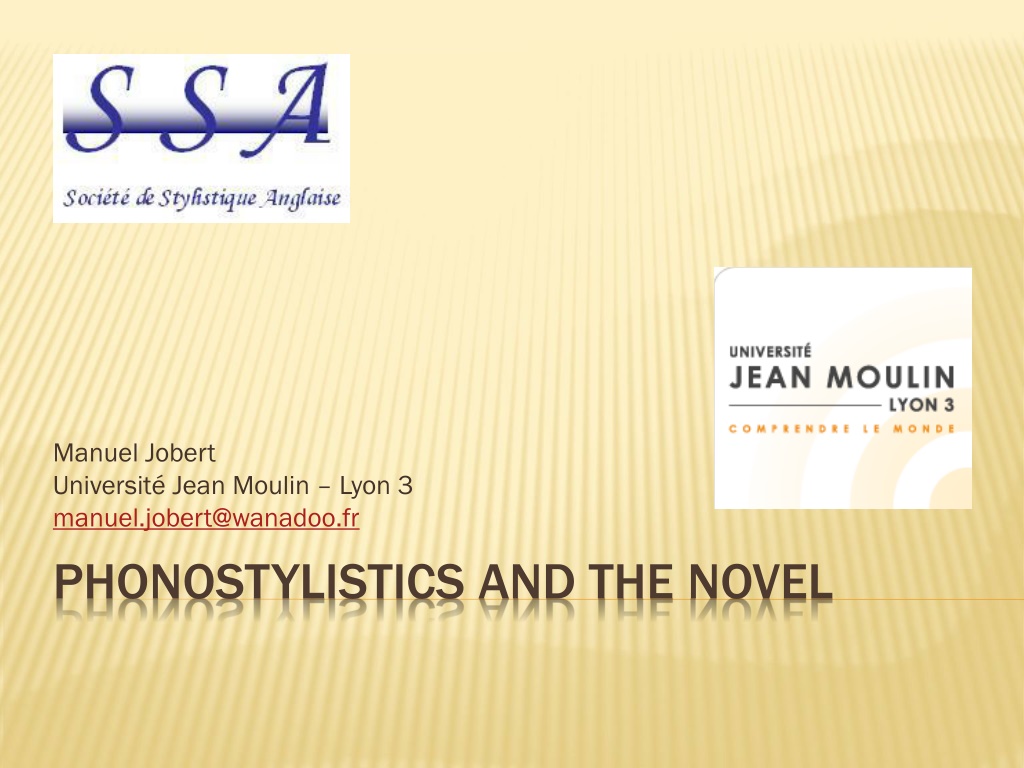

![Prevention and Combating of Hate Crimes and Hate Speech Bill [B.9B.2018]](/thumb/60513/prevention-and-combating-of-hate-crimes-and-hate-speech-bill-b-9b-2018.jpg)
